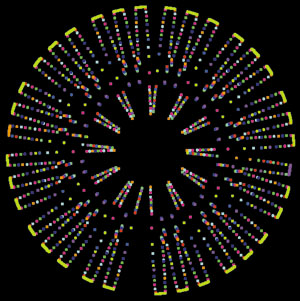
A theme that is common to many new particle colliders is the determined push to extend the physics reach by boosting the collision rate (luminosity).
In a particle collider ring, the counter-rotating beams are able to “sense” the electromagnetic effects of each other even before the particles collide. This infamous “beambeam effect” is complex and can have all kinds of results, sometimes unexpected. These can include decreased collision rates through beam blow-up, and orbit distortions and instabilities.
With CERN’s LHC proton collider aiming for very high collision rates (luminosity), such effects could easily degrade performance. To boost the particle supply and the collision rate, today’s colliders use ingenious bunched beams that interlace as they collide.
To minimize deleterious beambeam effects, new colliders using many bunches make them cross each other at an angle rather than colliding head-on. However, even a few long-range effects can couple all circulating bunches.
For the LHC, progress was summarized at an LHC99 BeamBeam workshop at CERN in April. The discussions were organized in two working groups.The first was on incoherent or weakstrong beambeam effects and was chaired by Eberhard Keil of CERN. The other was on coherent or strongstrong beam-beam effects and was chaired by Kaoru Yokoya of the Japanese KEK laboratory.
A vital part of this work is to decide on an optimal beam bunch scenario to fill the LHC rings with particles. With beambeam effects being hard to predict, experience as new machines explore new energy regimes is extremely valuable. For the LHC, the new working conditions at Fermilab’s Tevatron protonantiproton collider, which is also striving for very high collision rates, will provide valuable input. Further experience will come from another new collider Brookhaven’s RHIC. Like the LHC, this uses two beam pipes.
Experimental data from the PEP-II electronpositron collider at SLAC, Stanford, US, which uses head-on collisions, and from the KEKB electronpositron collider at KEK, Japan, which uses a beam-crossing angle, will also be highly relevant. Complementary input comes from simulation program, which try to predict beambeam effects. This work is not easy, but different approaches seem to be converging.





